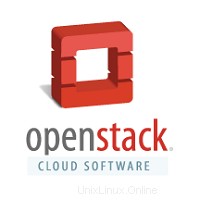
Dies ist der zweite Teil der Konfiguration von Neutron (Networking) unter Ubuntu 14.04. Sie können den vorherigen Artikel zum Konfigurieren von Neutron Nr. 1 durchgehen, in dem wir Netzwerkkomponenten auf dem Controller-Knoten installiert und konfiguriert haben.
Hier, in diesem Tutorial, werden wir Compute Node installieren und konfigurieren.
Installieren Sie zunächst die Komponenten auf dem Rechenknoten.
# apt-get install neutron-plugin-linuxbridge-agent conntrack
Rechenknoten konfigurieren:
Lets do some command configuration umfasst den Authentifizierungsmechanismus, die Nachrichtenwarteschlange und das Plug-in
Bearbeiten Sie die Datei /etc/neutron/neutron.conf.
# nano /etc/neutron/neutron.conf
Nehmen Sie die entsprechenden Änderungen an der Datei vor.
[DEFAULT] ... rpc_backend = rabbit auth_strategy = keystone verbose = True [oslo_messaging_rabbit] ... rabbit_host = controller rabbit_userid = openstack rabbit_password = password ## Replace "password" with the password you chose for the openstack account in RabbitMQ. [keystone_authtoken] ... auth_uri = http://controller:5000 auth_url = http://controller:35357 auth_plugin = password project_domain_id = default user_domain_id = default project_name = service username = neutron password = password ## Replace "password" with the password you chose for the neutron user in the Identity service. ## Commentout other authentication details. [database] #connection = sqlite:////var/lib/neutron/neutron.sqlite ## Comment out any connection options because compute nodes do not directly access the database.
Konfigurieren Sie den Linux-Bridge-Agent:
Da wir Self-Service-Netzwerke verwenden, müssen wir den Linux-Bridge-Agent auf einem Compute-Knoten konfigurieren. Der Linux-Bridge-Agent erstellt eine virtuelle Layer-2-Netzwerkinfrastruktur für Instanzen, die VXLAN-Tunnel für private Netzwerke enthält und Sicherheitsgruppen verwaltet.
Bearbeiten Sie die Datei /etc/neutron/plugins/ml2/linuxbridge_agent.ini.
# nano /etc/neutron/plugins/ml2/linuxbridge_agent.ini
Nehmen Sie Änderungen an der Datei vor.
[linux_bridge] physical_interface_mappings = public:eth1 ## Replace "eth1" with the name of the physical public facing network interface. [vxlan] enable_vxlan = True local_ip = 192.168.12.22 l2_population = True ## Replace "192.168.12.22" with the management ip-address of compute node. [agent] ... prevent_arp_spoofing = True [securitygroup] ... enable_security_group = True firewall_driver = neutron.agent.linux.iptables_firewall.IptablesFirewallDriver
Compute für die Verwendung des Netzwerks konfigurieren:
Bearbeiten Sie die Datei /etc/nova/nova.conf.
# nano /etc/nova/nova.conf
Nehmen Sie die Änderungen an der Datei wie unten beschrieben vor.
[neutron] url = http://controller:9696 auth_url = http://controller:35357 auth_plugin = password project_domain_id = default user_domain_id = default region_name = RegionOne project_name = service username = neutron password = password ## Replace "password" with the password you chose for the neutron user in the Identity service.
Installation abschließen:
Starten Sie den Compute-Dienst neu:
# service nova-compute restart
Starten Sie den Linux-Bridge-Agent neu:
# service neutron-plugin-linuxbridge-agent restart
Überprüfen:
Agenten auflisten, um den erfolgreichen Start der Neutronenagenten zu überprüfen, führen Sie diesen Befehl auf dem Controller-Knoten aus.
# neutron agent-list +--------------------------------------+--------------------+--------------------------+-------+----------------+---------------------------+ | id | agent_type | host | alive | admin_state_up | binary | +--------------------------------------+--------------------+--------------------------+-------+----------------+---------------------------+ | 02030132-55f1-4136-8b47-7b495b66c672 | L3 agent | controller.itzgeek.local | :-) | True | neutron-l3-agent | | 6b2fd77d-8b23-4932-8010-6436bf01319c | Metadata agent | controller.itzgeek.local | :-) | True | neutron-metadata-agent | | 9324094a-878c-4ba2-b822-7b070268deec | DHCP agent | controller.itzgeek.local | :-) | True | neutron-dhcp-agent | | cac6003d-b25a-4b1f-8144-1ae0293f26b0 | Linux bridge agent | compute.itzgeek.local | :-) | True | neutron-linuxbridge-agent | | faec1d38-5b5a-4c46-a614-4db12b4ff9e6 | Linux bridge agent | controller.itzgeek.local | :-) | True | neutron-linuxbridge-agent | +--------------------------------------+--------------------+--------------------------+-------+----------------+---------------------------+
Sie sollten die obige Ausgabe mit vier Agenten auf dem Controller-Knoten sehen und ein Agent auf jedem Rechenknoten .